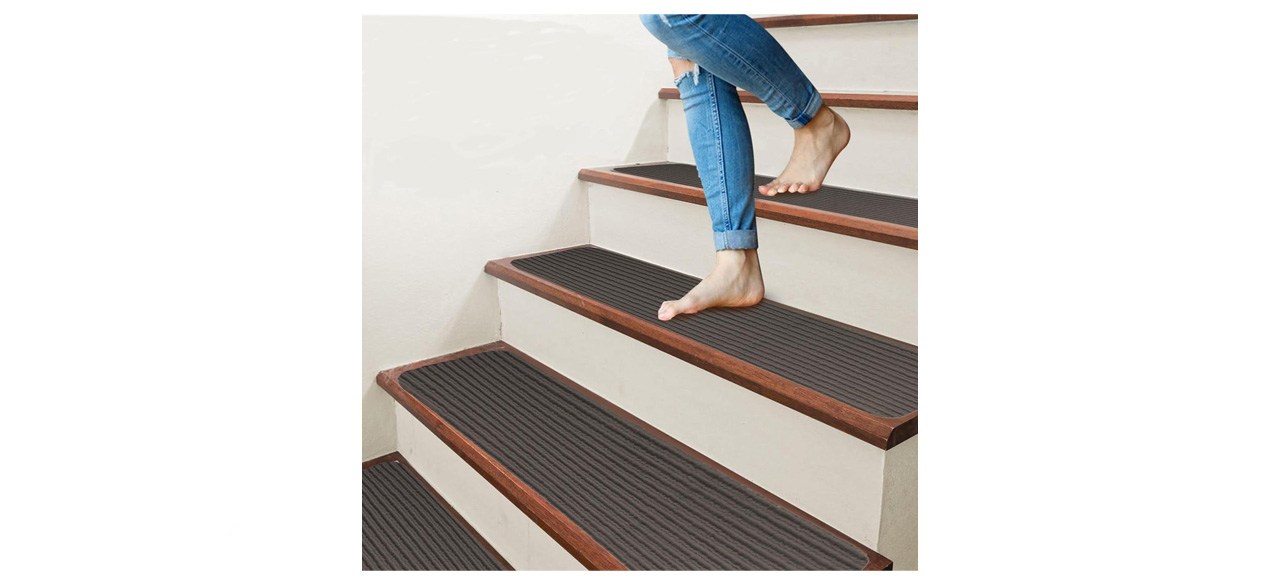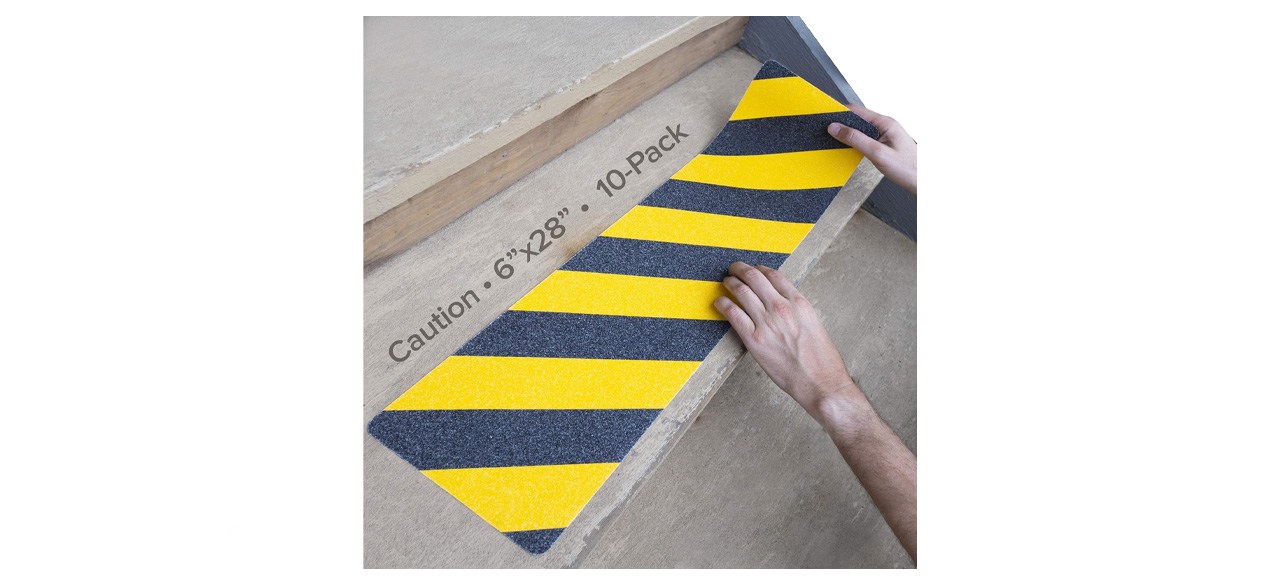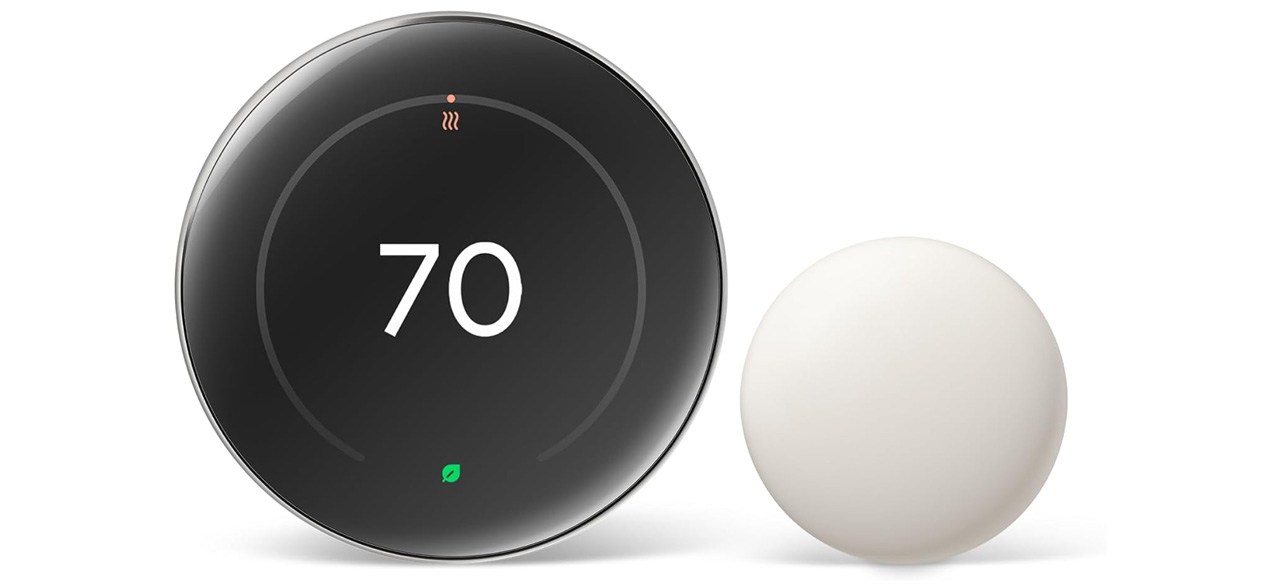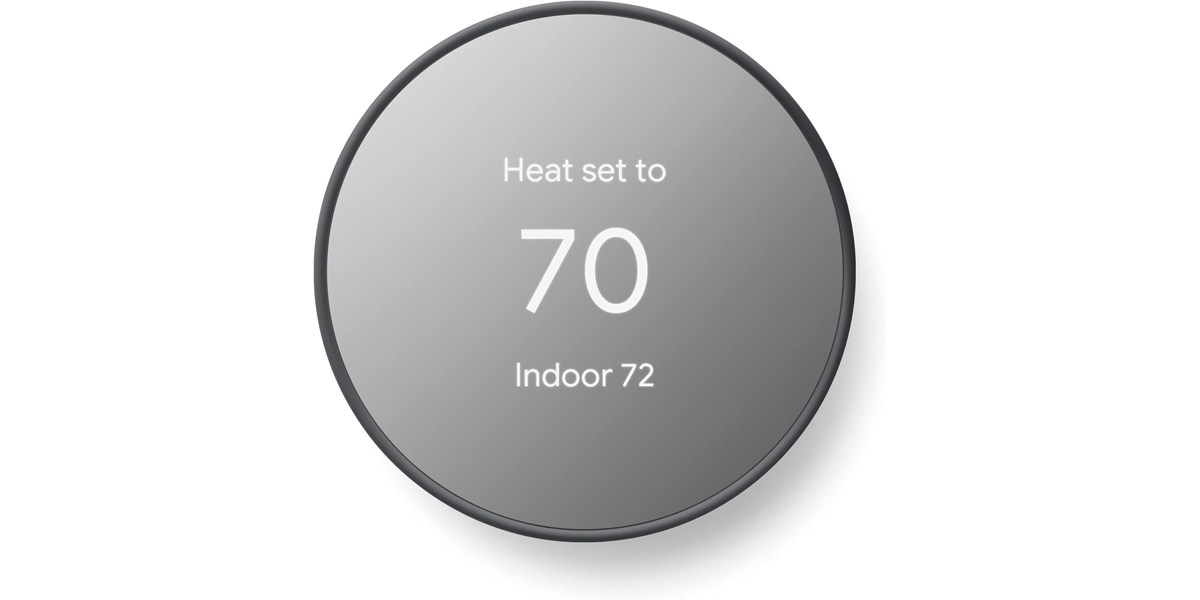
Iran accelerates production of near weapons-grade uranium, IAEA says, as tensions with US ratchet up
- February 26, 2025
VIENNA (AP) — Iran has accelerated its production of near weapons-grade uranium as tensions between Tehran and Washington rise after the election of U.S. President Donald Trump, a report by the United Nations’ nuclear watchdog seen by The Associated Press on Wednesday showed.
The report by the Vienna-based International Atomic Energy Agency said that as of Feb. 8, Iran has 274.8 kilograms (605.8 pounds) of uranium enriched up to 60%. That’s an increase of 92.5 kilograms (203.9 pounds) since the IAEA’s last report in November.
That material is a short, technical step away from weapons-grade levels of 90%.
A report in November 2024 put the stockpile at 401.9 pounds. It had 363.1 pounds last August.
“The significantly increased production and accumulation of high enriched uranium by Iran, the only non-nuclear weapon State to produce such nuclear material, is of serious concern,” the confidential report stated. According to the IAEA, approximately 42 kilograms of 60% enriched uranium is theoretically enough to produce one atomic bomb, if enriched further to 90%.

The IAEA also estimated in its quarterly report that as of Feb. 8, Iran’s overall stockpile of enriched uranium stands at 8,294.4 kilograms (18,286 pounds), which represents an increase of 1,690.0 kilograms (3725.8 pounds) since the last report in November.
During his first presidential term, Trump unilaterally withdrew the U.S. from Tehran’s nuclear deal with world powers and reimposed sanctions on Iran. He also ordered the 2020 killing of Qassem Soleimani, who led the Iranian Islamic Revolutionary Guard Corps’ Quds Force.
Iran signals it could pursue nuclear weapons
Iran has maintained its nuclear program is for peaceful purposes only, but the IAEA chief, Rafael Mariano Grossi, has previously warned that Tehran has enough uranium enriched to near-weapons-grade levels to make “several” nuclear bombs if it chose to do so.
Iranian officials have increasingly suggested Tehran could pursue an atomic bomb. U.S. intelligence agencies assess that Iran has yet to begin a weapons program, but has “undertaken activities that better position it to produce a nuclear device, if it chooses to do so.”
Iran’s accelerated production of near weapons-grade uranium puts more pressure on Trump as he’s repeatedly said he’s open to negotiations with the Islamic Republic while also increasingly targeting Iran’s oil sales with sanctions as part of his reimposed “maximum pressure” policy.
Even Iran’s Supreme Leader Ayatollah Ali Khamenei, who has final say on all state matters, in a speech in August opened the door to talks with the U.S., saying there is “no harm” in engaging with the “enemy.”
More recently, he tempered that, saying that negotiations with America “are not intelligent, wise or honorable” after Trump floated nuclear talks with Tehran.
Iran refuses to reconsider ban on IAEA inspectors
The IAEA already warned last December that Iran was poised to “quite dramatically” increase its stockpile of near weapons-grade uranium as it has started operating cascades of advanced centrifuges.
That move came as a response to the Board of Governors at the IAEA passing a resolution condemning Iran for failing to cooperate fully with the agency. In the past, Iran has repeatedly responded to resolutions by the IAEA Board of Governors by further enhancing its nuclear program.
Wednesday’s report also said that Iran has also not reconsidered its September 2023 decision to ban some of the agency’s most experienced inspectors from monitoring its nuclear program.
“The Director General deeply regrets that Iran, despite having indicated a willingness to consider accepting the designation of four additional experienced Agency inspectors, did not accept their designations,” the report said.
 Orange County Register
Orange County Register

Guantánamo needs to be shut down, not expanded
- February 26, 2025
In a deeply disturbing and unprecedented move, the U.S. has begun transferring immigrant detainees to Guantánamo Bay, Cuba. They’re being held without access to their lawyers and families.
President Trump has ordered up to 30,000 “high-priority” migrants to be imprisoned there as part of his larger mass deportation and detention campaign.
Trump claims these migrants are the “worst criminal aliens threatening the American people.” But recent investigations of those detainees have already challenged this narrative. And a large percentage of immigrants arrested in the U.S. have no criminal record.
Unfortunately, this isn’t the first time our government has invoked “national security” to deny marginalized communities their basic human rights. President George W. Bush created the infamous military prison at Guantánamo during the “War on Terror” to hold what his administration called the “worst of the worst.”
The prison has since become synonymous with indefinite detention — 15 people still remain there today, over 20 years later. Notorious for its brutality and lawlessness, Guantánamo should be shut down, not expanded.
Of the 780 Muslim men and boys imprisoned there since January 2002, the vast majority have been held without charge or trial. Most were abducted and sold to the U.S. for bounty and “had no relationship whatsoever with the events that took place on 9/11,” reported the UN’s independent expert in 2023, who reiterated the global call to close Guantánamo.
The Bush administration designed the prison to circumvent the Constitution and the 1949 Geneva Conventions, refusing to treat the prisoners as either POWs or civilians. This legal fiction resulted in a range of human rights violations, including torture.
But the Constitution — and international law — still applies wherever the U.S. government operates. All prisoners, including immigrants, are still entitled to humane treatment, legal counsel, and due process.
“Never before have people been taken from U.S. soil and sent to Guantánamo, and then denied access to lawyers and the outside world,” said Lee Gelernt, the lead attorney in the ACLU case challenging Trump’s executive order.
However, the U.S. does have a sordid history of detaining migrants captured elsewhere at the base. As legal scholar Jeffrey S. Kahn points out, the U.S. has detained Haitians at Guantánamo on and off since the 1970s.
In the 1990s, thousands of Haitian refugees fleeing persecution following a military coup were captured at sea. The U.S. held them in horrific conditions at Guantánamo so they couldn’t reach U.S. shores to seek asylum — which is a fundamental human right long enshrined under U.S. law.
Shrouded in secrecy, the U.S. continues to capture and detain asylum seekers fleeing Haiti, Cuba, and other Caribbean countries at Guantánamo. Last fall, the International Refugee Assistance Project reported that refugee families are kept in a dilapidated building with mold and sewage problems, suffer from a lack of medical care, and are “detained indefinitely in prison-like conditions without access to the outside world.”
Trump’s order would take these abuses to a horrifying new level.
Currently, the base’s existing immigration detention facility can hold up 120 people. Expanding it to 30,000 will require enormous resources. The “War on Terror” prison at Guantánamo already costs an estimated $540 million annually, making it one of the most expensive prisons in the world.
Then there are the moral costs.
The mass deportation and detention of asylum seekers is not only unlawful but cruel — and not a real immigration solution. Instead, our government should prioritize meaningful immigration reform that recognizes the dignity of all people.
We should also shut down the “War on Terror” prison at Guantánamo once and for all — and pursue accountability for its decades of abuses. Otherwise, it will only continue to expand. “I can attest to the facility’s capacity for cruelty,” warned Mansoor Adayfi, who was subjected to torture and endured nearly 15 years at the prison.
Guantánamo’s legacy of injustice must end.
Farrah Hassen is a writer, policy analyst, and adjunct professor in the Department of Political Science at Cal Poly Pomona. This op-ed was distributed by OtherWords.org.
Orange County Register
Read More
Hamas will turn over bodies of 4 Israeli hostages in exchange for release of hundreds of prisoners
- February 26, 2025
By SAMY MAGDY and MELANIE LIDMAN, Associated Press
CAIRO (AP) — Hamas will return the bodies of four dead Israeli hostages on Thursday in exchange for Israel’s release of hundreds of Palestinian prisoners, the group said, just days before the first phase of the ceasefire between the warring parties was to expire.
Israel has delayed the release of about 600 Palestinian prisoners since Saturday to protest what it says is the cruel treatment of hostages during their release by Hamas.
The group has said that the delay is a “serious violation” of their ceasefire and that talks on a second phase aren’t possible until the Palestinians are freed.
Hamas spokesman Abdul Latif al-Qanou told The Associated Press on Wednesday that Hamas would hand over the bodies of four Israelis the next day.
In exchange, Israel would release the Palestinian prisoners, as well as an unspecified number of women and minors detained since the group’s Oct. 7, 2023 terrorist attack on Israel that sparked the conflict.
Hamas has been designated as a terrorist organization by the United States, Canada and the European Union.
An Israeli official confirmed that the bodies of four hostages were expected to be turned over but provided no further details. The official spoke on condition of anonymity because they weren’t authorized to speak with the media.
Israel and Hamas had already said on Tuesday that an agreement had been reached to return the bodies of the hostages, but no date had been announced.
Hamas has released hostages, and the bodies of four dead hostages, in large public ceremonies during which the Israelis were paraded and forced to wave to large crowds.
Israel, along with the Red Cross and U.N. officials, have said the ceremonies were humiliating to the hostages, and Israel last weekend delayed the scheduled prisoner release in protest.
There will be no public ceremony when the four bodies in the latest exchange are returned to Israel in the early hours of Thursday, according to a senior Hamas official who spoke on condition of anonymity because he wasn’t authorized to speak with the media.
A fragile ceasefire in peril
The deadlock over the exchange had threatened to collapse the ceasefire when the current six-week first phase of the deal expires this weekend.
The latest agreement would complete both sides’ obligations of the first phase of the ceasefire — during which Hamas is returning 33 hostages, including eight bodies — in exchange for nearly 2,000 Palestinian prisoners.

It also could clear the way for an expected visit this week by U.S. President Donald Trump’s Middle East envoy, Steve Witkoff, to the region.
Witkoff has said that he wants the sides to move into negotiations on the second phase, during which all remaining hostages held by Hamas are to be released and an end to the war is to be negotiated. The Phase 2 talks were supposed to begin weeks ago, but never did.
The ceasefire, brokered by the United States, Egypt and Qatar, ended 15 months of heavy fighting that erupted after Hamas’ 2023 attack on southern Israel that killed about 1,200 people. About 250 people were taken hostage.
Israel’s military offensive has killed more than 48,000 Palestinians, according to Palestinian health officials, displaced an estimated 90% of Gaza’s population and decimated the territory’s infrastructure and health system. The Hamas-run Health Ministry doesn’t differentiate between civilian and militant deaths, but it says that over half of the dead have been women and children.
Another infant in Gaza dies of hypothermia
With people are living in tent camps and damaged buildings in the Gaza Strip, health officials said another infant had died of hypothermia Wednesday, bringing the toll to seven over the past two weeks.
Dr. Munir al-Boursh, director general of Gaza’s Health Ministry, said a baby less than two months old died due to the “severe cold wave” that has hit the Palestinian enclave.
Temperatures have been below 50 degrees Fahrenheit at night and the last few days have been particularly cold.
Lidman reported from Tel Aviv, Israel. Associated Press writer David Rising in Bangkok contributed to this report. Follow AP’s war coverage at https://apnews.com/hub/israel-hamas-war
 Orange County Register
Orange County Register

Wind advisory affecting Orange County Thursday
- February 26, 2025
Orange County is the focus of a wind advisory issued at 2:55 a.m. on Wednesday by the National Weather Service. The advisory is valid for Thursday, Feb. 27 between midnight and 4 p.m.
The NWS San Diego CA said, “East winds 20 to 30 mph with gusts up to 55 mph expected.”
“Gusty winds will blow around unsecured objects. Tree limbs could be blown down and a few power outages may result,” the NWS said. “Winds this strong can make driving difficult, especially for high profile vehicles. Use extra caution.”
The full list of affected locations includes:
- San Bernardino and Riverside County Valleys
- San Diego County Inland Valleys
- Riverside County Mountains
- Santa Ana Mountains/Foothills
- San Diego County Mountains
- San Gorgonio Pass Near Banning
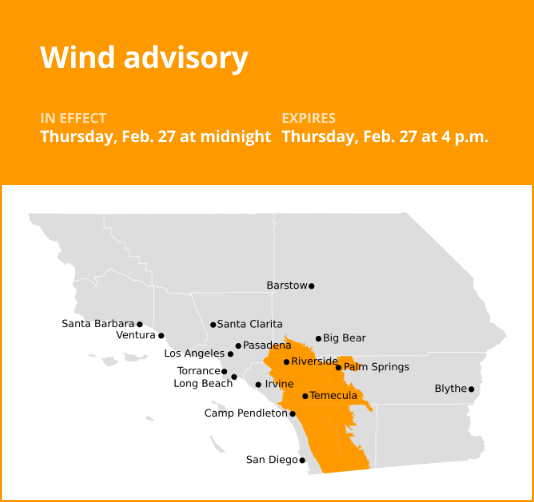
 Orange County Register
Orange County Register

Orange County under a wind advisory Thursday
- February 26, 2025
The National Weather Service issued a wind advisory at 2:55 a.m. on Wednesday valid for Thursday, Feb. 27 between midnight and 4 p.m. for Orange County.
The NWS San Diego CA said, “East winds 20 to 30 mph with gusts up to 50 mph expected.”
“Low visibility could make driving conditions hazardous this morning. Gusty winds will blow around unsecured objects late tonight and Thursday. Tree limbs could be blown down and a few power outages may result for late tonight and Thursday,” the NWS said. “Winds this strong can make driving difficult, especially for high profile vehicles. Use extra caution. If driving, slow down, use your headlights, and leave plenty of distance ahead of you.”
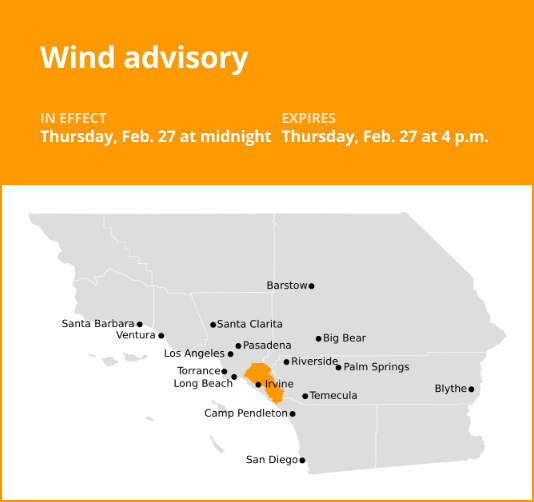
 Orange County Register
Orange County Register

Best stair treads
- February 26, 2025
Which stair treads are best?
Stairs, whether indoors or outdoors, can be dangerous for some people and even animals to use. Stair treads aim to remove much of the risks by providing a high-traction surface to your otherwise risky surfaces. They aren’t all about function though — many stair treads have fun and attractive patterns if you simply want to liven up your stairs.
The best stair treads are the Bungalow Flooring Waterhog Stair Treads, Boxwood Collection. The design is pleasingly floral, and they don’t require adhesive to stay put.
What to know before you buy stair treads
Size
Stair treads come in all sizes to best fit any size of stairs. Before shopping, measure your stairs’ surface area. Covering the entirety of it is unlikely, plus it rarely looks good. As such, aim to find stair treads that leave roughly 1-2 inches of empty space on the sides and no more than 1 inch of empty space on the top and bottom. Most stair treads are 22-36 inches long.
Quantity
Stair treads always come in packs, with most packs including between two and 15 treads. Pay close attention to how many treads are included. It can often be hard to parse through all the numbers thrown at you in product descriptions to find the count.
When determining how many treads you need, remember to count the floors as well. For example, if you have stairs with three steps, you should buy five treads: three for the actual steps and one each for the top and bottom floor.
Design
Most stair treads are simple one-color pieces, but others offer all manner of designs. Most of these designs are purely decorative, but others may have special properties, such as being reflective or glow-in-the-dark.
What to look for in quality stair treads
Easy installation
The best stair treads include a way to be installed. This usually takes the form of specialized pre-applied adhesive but bottoms covered in rubber can have plenty of grip without needing adhesive.
Common installation methods for treads that don’t include a method are double-sided tape and staples, both of which can damage the stairs underneath.
Resistances
There are three important resistances to check for when shopping for high-quality stair treads: moisture, stain and fade.
- Moisture resistance is more important for outdoor treads as they’ll be in direct contact with rain, etc. Indoor treads also need resistance as the bottoms of your shoes will drag in moisture.
- Stain resistance focuses on fighting off the effects of mud, grass and any other debris shoes attract.
- Fade resistance also keeps your treads looking fresh. Outdoor treads will need to resist the bleaching effects of direct sunlight while indoor treads will need to resist higher levels of traffic.
How much you can expect to spend on stair treads
Stair treads come in packs of varying costs making it best to focus on the price per tread. Low-cost treads typically cost less than $5 with midrange treads costing $5-$10 and high-cost treads running up to $20 or more.
Stair treads FAQ
How should I prepare my stairs before adding treads?
A. Your stairs need to be as clean and as dry as possible before adding your new treads. Use a wet cloth to remove as much dirt, debris and any residues first, followed by thoroughly drying the stairs with a separate cloth. Don’t apply your treads until your stairs are completely dry, letting them air out after manually drying them if need be.
What’s the best adhesive to use with stair treads?
A. The best adhesive depends on what stair treads you have. Most stair tread products directly recommend certain types of adhesive to use with double-sided tape being the most frequently recommended. Better stair treads include peel-and-stick adhesives so you don’t need to worry about it.
What are the differences between indoor and outdoor stair treads?
A. The main differences are material and level of traction. Outdoor stair treads are usually made of rubber or plastic so they can best resist all the effects of weather. They also typically have higher levels of traction as many outdoor stairs have no guardrail to hold on to.
What are the best stair treads to buy?
Top stair treads
Bungalow Flooring Waterhog Stair Treads, Boxwood Collection
What you need to know: The leaf pattern adds a little touch of elegance compared to plain treads.
What you’ll love: They’re available in seven colors and four sizes and can be used indoors and out. Each square yard of tread can hold up to 1.5 gallons of water. They use a rubber grip underneath that can hold to any surface.
What you should consider: It only includes four treads per pack, making it expensive — even more so for the larger-sized treads. Some consumers had issues with the treads curling up on the ends.
Top stair treads for the money
EdenProducts Nonslip Carpet Stair Treads
What you need to know: These are perfect for indoor stairs.
What you’ll love: They measure 8 inches by 30 inches and come in five colors and multiple pack sizes. It uses an anti-moving backing, not an adhesive, so your stairs remain undamaged. They can be cleaned via vacuum or by tossing them in your washing machine.
What you should consider: The adhesive on the back struggles to stick to slick stairs. They are shipped folded over and need to be pressed flat before installing them.
Worth checking out
LifeGrip Antislip Traction Treads
What you need to know: These are an excellent purchase for outdoor stairs.
What you’ll love: These come in a pack of 10 and are available in three sizes. They come in four designs — standard black, black and yellow caution, black with a glow-in-the-dark strip and black with a reflective strip. Installation is as easy as peeling and sticking.
What you should consider: The adhesive may come undone in harsh weather conditions. They are packaged in a wound-up roll, so they need to be flattened before installation.
Prices listed reflect time and date of publication and are subject to change.
Check out our Daily Deals for the best products at the best prices and sign up here to receive the BestReviews weekly newsletter full of shopping inspo and sales.
BestReviews spends thousands of hours researching, analyzing and testing products to recommend the best picks for most consumers. BestReviews and its newspaper partners may earn a commission if you purchase a product through one of our links.
 Orange County Register
Orange County Register

Best Nest thermostat
- February 26, 2025
Which Nest thermostat is best?
Smart thermostats are one of the best ways to keep your home at a comfortable temperature while simultaneously saving money on your energy bill every month. Without a doubt, Google Nest devices lead the pack when it comes to overall functionality, and many would say aesthetics as well.
If looking for the most advanced functionality and the highest level of compatibility with various HVAC units, the Google Nest Learning Thermostat 4th Generation should be your go-to choice. It offers machine learning and boasts the company’s Farsight feature that automatically lights up when it detects you in the room. Also, it comes in several metallic finishes that give it a sleek look.
What to know before you buy a Nest thermostat
Nest thermostats can save you money
Many people buy Nest thermostats simply for their convenience. They integrate with Alexa for voice control and also operate remotely via the associated application. There is another excellent reason for buying a Nest thermostat, though, and that is they can save you money.
Based on reports published by Google, installing a Nest thermostat in the home saves consumers an average of 15% on their cooling bills and 10-12% on their heating bills. If you prefer to get your information from unbiased third parties, you’ll be interested to learn that many actual users say they save from $10-$20 a month.
Nest thermostats accomplish this in several ways, including scheduling, machine learning, HVAC monitoring and geofencing. You can also improve your Nest’s ability to save you money by adding sensors in different rooms of your home.
Energy usage reports
Nests tracks your HVAC system’s energy use and produce a monthly report. The report shows metrics, including how much the system runs, how energy use compares month-to-month, the impact of weather on energy use and more. With this information, you’ll be more aware of your energy usage, so it will be easier to make informed decisions that can save you additional money on your heating and cooling bills.
Compatibility
Nest thermostats are compatible with most HVAC systems, but not all. The few systems that are not compatible include proprietary and high-voltage systems, millivolt heaters, microcontroller systems that lack a C-wire and solid-fuel systems. They may also not work with systems that use wired remote sensors. A complete list of compatible systems is available on the company’s support website.
Features to look for in a Nest thermostat
Machine learning
The Nest Learning and Nest E models have a machine learning feature that will automatically create a custom schedule based on your usage habits. Use the associated app to adjust the temperature as needed. Over time, the thermostat learns household preferences, removing the need for manual adjustments. This feature is the default setting, but you can turn it off.
Scheduling
The basic Nest Thermostat, the company’s most affordable model, doesn’t have machine learning. However, it can still save you money through the use of its scheduling feature. During the initial setup, it prompts the user to set a heating and cooling schedule manually. Alternatively, users can use the Quick Schedule feature, which creates a program based on the national average’s most efficient schedule.
Display
Your Nest thermostat may have a frosted mirror display that blends in with the outer ring or a high-resolution color display, depending on your chosen model. Both feature easy-to-read digits, but the high-resolution color display also boasts Farsight, which allows it to automatically light up and show the time, current temperature, target temperature and weather when it detects you across the room.
Housing color and material
Most nest thermostats come in several colors so that you can match them to the decor of your home. Depending on the model you choose, it may have a metal ring around the exterior or an all-plastic housing.
How much does a Nest thermostat cost?
Nest thermostats cost $100-$250, but you can find more expensive packages bundled with up to three remote sensors.
Nest thermostat FAQ
Are Nest thermostats difficult to install?
A. Most people will find the Nest thermostat relatively easy to install in 30 minutes or less as long as you already have all of the existing wiring. If you need to install new wiring and aren’t familiar with electrical work, it may be better to hire a professional.
Do Nest thermostats work without Wi-Fi?
A. A Nest thermostat can function without an internet connection, but functionality is limited to the programmable, nonsmart thermostat.
What is the best Nest thermostat to buy?
Top Nest thermostat
Google Nest Learning Thermostat 4th Generation
What you need to know: Google’s most advanced model, the Nest Learning 4th Generation, includes tons of features that save money without sacrificing comfort.
What you’ll love: It has a premium look with its bright, high-resolution display and a metallic ring available in several finishes. Also, it offers the Farsight feature so you can easily see the current temperature and other pertinent information from across the room.
What you should consider: It tends to stand out noticeably on a wall rather than blend in with it.
Top Nest thermostat for the money
What you need to know: The affordable price of the basic Nest Thermostat makes it a good choice for those on a tight budget who still want to give their HVAC smart functionality.
What you’ll love: You can manually program it with a custom schedule that fits your lifestyle, and the mirrored display gives it a discreet look that blends into walls well.
What you should consider: It isn’t compatible with as many HVAC systems as other models.
Worth checking out
What you need to know: Other than Farsight, The Nest Thermostat E offers nearly all the same functionality as the Nest Learning 4th Generation but at a lower price.
What you’ll love: It automatically adjusts itself to an eco-friendly temperature when you leave the house, and it notifies you with a leaf logo when you have manually chosen an energy-saving temperature.
What you should consider: It only comes in white.
Prices listed reflect time and date of publication and are subject to change.
Check out our Daily Deals for the best products at the best prices and sign up here to receive the BestReviews weekly newsletter full of shopping inspo and sales.
BestReviews spends thousands of hours researching, analyzing and testing products to recommend the best picks for most consumers. BestReviews and its newspaper partners may earn a commission if you purchase a product through one of our links.
 Orange County Register
Orange County Register

Dense fog advisory affecting Orange County until Wednesday morning
- February 26, 2025
San Diego County Coastal Areas, Orange County Coast and Orange County are the focus of a dense fog advisory issued at 2:24 a.m. on Wednesday by the National Weather Service. The advisory is in effect until 9 a.m.
The NWS San Diego CA says to anticipate, “Visibility one quarter mile or less in dense fog.”
“Low visibility could make driving conditions hazardous,” the NWS said. “If driving, slow down, use your headlights, and leave plenty of distance ahead of you.”
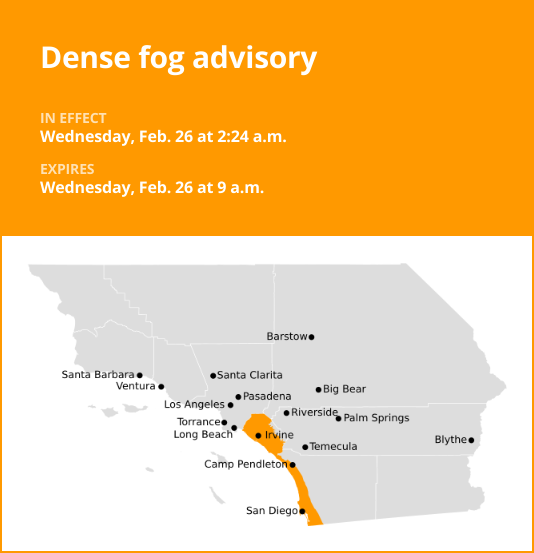
Fog safety: Tips from the NWS for safe travels
If a dense fog advisory is issued for your area, it means that widespread dense fog has developed and visibility often drops to just a quarter-mile or less. These conditions can make driving challenging, so exercise extreme caution on the road, and if possible, consider delaying your trip.
If driving through fog becomes inevitable, remember these safety guidelines:
Moderate your speed:
Slow down and allocate extra travel time to reach your destination safely.
Visibility matters:
Ensure your vehicle is visible to others by using low-beam headlights, which automatically activate your taillights. Utilize fog lights if your vehicle is equipped with them.
Avoid high-beams:
Refrain from using high-beam headlights, as they create glare that impairs your visibility on the road.
Keep your distance:
Keep a considerable following distance to account for sudden stops or shifts in traffic patterns.
Stay in your lane:
Use the road’s lane markings as a guide to remaining in the correct lane.
Zero visibility strategy:
In extremely dense fog where visibility is near zero, the best course of action is to first turn on your hazard lights, then simply pull into a safe location such as a parking lot of a local business, and stop.
Limited parking options:
If no designated parking area is available, pull your vehicle as far off the road as possible. Once stationary, deactivate all lights except the hazard flashers, engage the emergency brake, and release the brake pedal to ensure your tail lights remain unlit, minimizing the chance of other drivers colliding with your stationary vehicle.
By adhering to these precautions from the NWS, you can navigate foggy conditions more safely, reducing the likelihood of accidents and ensuring your personal safety.
 Orange County Register
Orange County Register
News
- ASK IRA: Have Heat, Pat Riley been caught adrift amid NBA free agency?
- Dodgers rally against Cubs again to make a winner of Clayton Kershaw
- Clippers impress in Summer League-opening victory
- Anthony Rizzo back in lineup after four-game absence
- New acquisition Claire Emslie scores winning goal for Angel City over San Diego Wave FC
- Hermosa Beach Open: Chase Budinger settling into rhythm with Olympics in mind
- Yankees lose 10th-inning head-slapper to Red Sox, 6-5
- Dodgers remain committed to Dustin May returning as starter
- Mets win with circus walk-off in 10th inning on Keith Hernandez Day
- Mission Viejo football storms to title in the Battle at the Beach passing tournament

